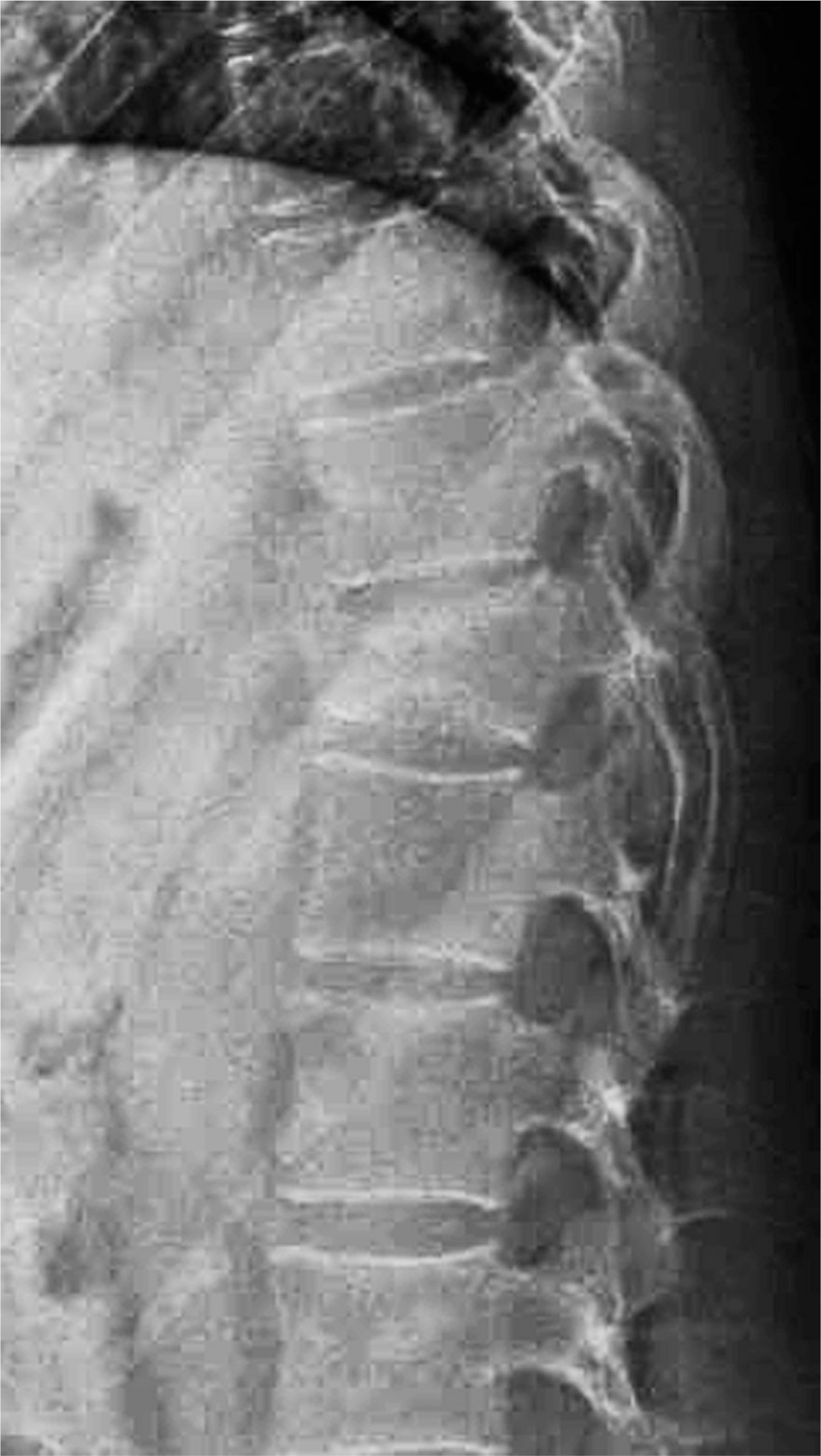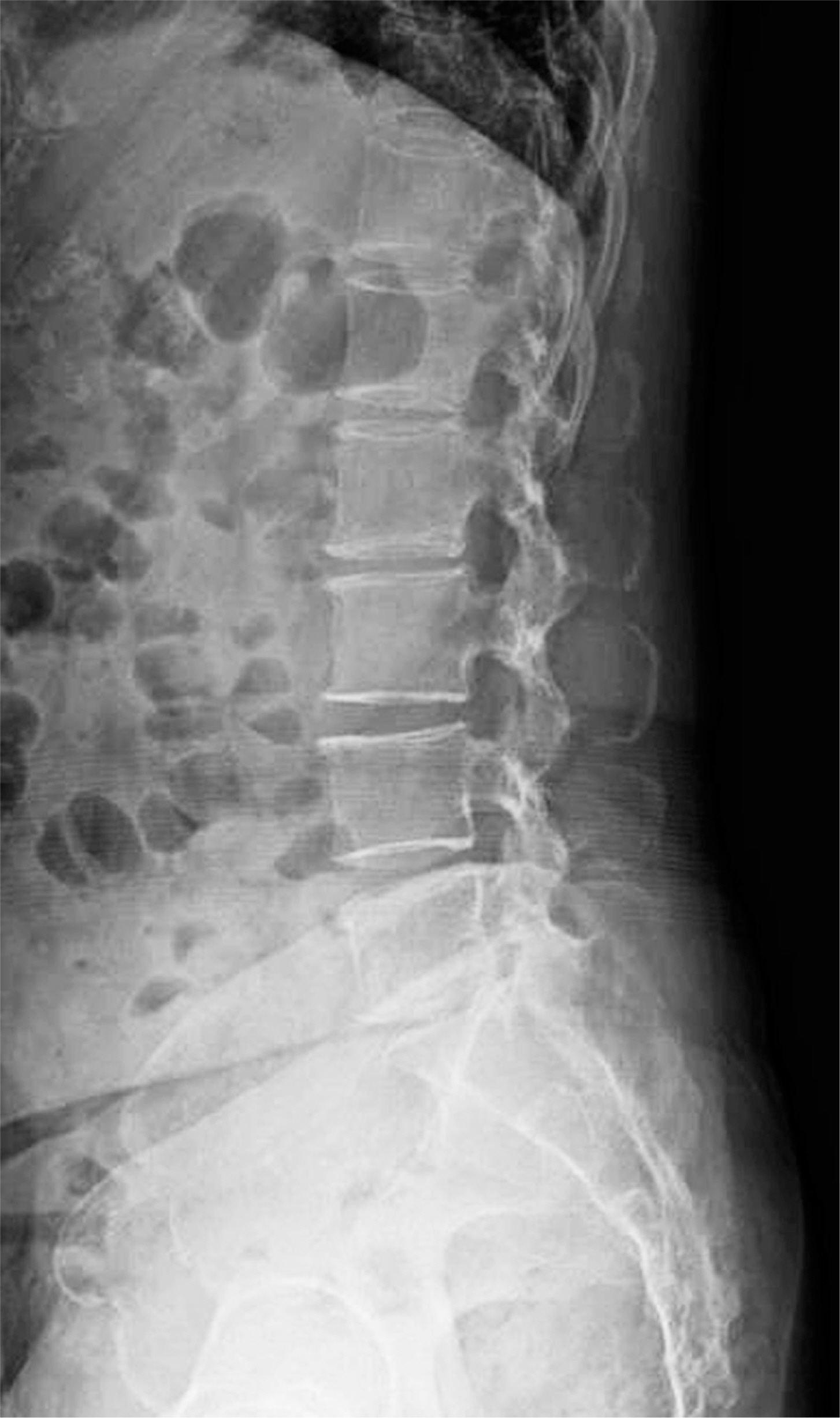J Korean Soc Spine Surg.
2017 Mar;24(1):1-6. 10.4184/jkss.2017.24.1.1.
Risk Factors for Osteoporotic Vertebral Fracture in Cushing Syndrome
- Affiliations
-
- 1Department of Orthopaedic Surgery, Gwangmyeong Sungae Hospital, Korea. faridat80@gmail.com
- KMID: 2402836
- DOI: http://doi.org/10.4184/jkss.2017.24.1.1
Abstract
- STUDY DESIGN: Retrospective study.
OBJECTIVES
The goal of this study was to evaluate the risk factors of osteoporotic vertebral fractures (OVFs) in patients with Cushing syndrome. SUMMARY OF LITERATURE REVIEW: In most reports, vertebral fractures in Cushing syndrome have been found to be related to osteoporosis. However, few studies have analyzed the clinical risk factors for OVFs.
MATERIALS AND METHODS
Thirty-two patients with Cushing syndrome who visited the orthopaedic department complaining of back pain were included in this study. Standing lateral X-rays were performed to evaluate the presence of vertebral fractures, and bone mineral density (BMD) was measured.
RESULTS
Of the 32 patients with Cushing syndrome with back pain, 8 (25%) were diagnosed with OVFs using morphometric criteria. The average weight and body mass index of the vertebral fracture group (VF group) were significantly higher than the values observed in the non-vertebral fracture group (non-VF group) (p=0.004, p=0.018). Lumbar BMD was significantly lower in the VF group (p=0.006). A risk factor for OVFs in Cushing syndrome was osteoporosis (odds ratio=18.56, 95% confidence interval=1.72-200.21, p=0.016) regardless of gender, obesity, menopause, or urine free cortisol levels.
CONCLUSIONS
OVFs in Cushing syndrome have been associated with overweight, and overweight is an indicator of compliance in the treatment of Cushing syndrome. Therefore, weight reduction and the prevention of osteoporosis should be emphasized in patients with Cushing syndrome to prevent OVFs.
Keyword
MeSH Terms
Figure
Reference
-
1. Cushing H. The basophil adenomas of the pituitary body. Ann R Coll Surg Engl. 1969; 44:180–1.2. Rodino MA, Shane E. Osteoporosis after organ transplan-tation. Am J Med. 1998; 104:459–69.
Article3. Canalis E. Clinical review 83: Mechanisms of glucocorticoid action in bone: implications to glucocorticoid-induced osteoporosis. J Clin Endocrinol Metab. 1996; 81:3441–7.
Article4. Freehill AK, Lenke LG. Severe kyphosis secondary to glucocorticoid-induced osteoporosis in a young adult with Cushing's disease. A case report and literature review. Spine (Phila Pa 1976). 1999; 24:189–93.5. Johnell O, Kanis J. Epidemiology of osteoporotic fractures. Osteoporos Int. 2005; 16(Suppl):S3–7.
Article6. Tauchmanova L, Pivonello R, Di Somma C, et al. Bone de-mineralization and vertebral fractures in endogenous cortisol excess: role of disease etiology and gonadal status. J Clin Endocrinol Metab. 2006; 91:1779–84.7. Davies KM, Stegman MR, Heaney RP, et al. Prevalence and severity of vertebral fracture: the Saunders County Bone Quality Study. Osteoporos Int. 1996; 6:160–5.
Article8. Cummings SR, Melton LJ. Epidemiology and outcomes of osteoporotic fractures. Lancet. 2002; 359:1761–7.
Article9. Smith-Bindman R, Cummings SR, Steiger P, et al. A comparison of morphometric definitions of vertebral fracture. J Bone Miner Res. 1991; 6:25–34.
Article10. Reid IR. Glucocorticoid osteoporosis–mechanisms and management. Eur J Endocrinol. 1997; 137:209–17.
Article11. Israel E, Banerjee TR, Fitzmaurice GM, et al. Effects of in-haled glucocorticoids on bone density in premenopausal women. N Engl J Med. 2001; 345:941–7.
Article12. Manning PJ, Evans MC, Reid IR. Normal bone mineral density following cure of Cushing's syndrome. Clin Endocrinol (Oxf). 1992; 36:229–34.
Article13. Schousboe JT, Vokes T, Broy SB, et al. Vertebral Fracture Assessment: the 2007 ISCD Official Positions. J Clin Densi-tom. 2008; 11:92–108.
Article14. Reid IR, Ibbertson HK, France JT, et al. Plasma testosterone concentrations in asthmatic men treated with glucocorticoids. Br Med J (Clin Res Ed). 1985; 291:574.
Article15. Torlontano M, Chiodini I, Pileri M, et al. Altered bone mass and turnover in female patients with adrenal incidentaloma: the effect of subclinical hypercortisolism. J Clin Endocrinol Metab. 1999; 84:2381–5.
Article16. Sipahi S, Tuzun S, Ozaras R, et al. Bone mineral density in women with sarcoidosis. J Bone Miner Metab. 2004; 22:48–52.17. De Martin M, Pecori Giraldi F, Cavagnini F. Cushing's disease. Pituitary. 2006; 9:279–87.
Article18. Canalis E, Bilezikian JP, Angeli A, et al. Perspectives on glu-cocorticoid-induced osteoporosis. Bone. 2004; 34:593–8.
Article19. Di Somma C, Colao A, Pivonello R, et al. Effectiveness of chronic treatment with alendronate in the osteoporosis of Cushing's disease. Clin Endocrinol (Oxf). 1998; 48:655–62.
Article20. Center JR, Nguyen TV, Schneider D, et al. Mortality after all major types of osteoporotic fracture in men and women: an observational study. Lancet. 1999; 353:878–82.
Article21. Diacinti D, Pisani D, Barone-Adesi F, et al. A new predictive index for vertebral fractures: the sum of the anterior vertebral body heights. Bone. 2010; 46:768–73.
Article
- Full Text Links
- Actions
-
Cited
- CITED
-
- Close
- Share
- Similar articles
-
- Association Between Osteoporotic Vertebral Fracture and Body Mass Index
- A Case of Cushing Syndrome Diagnosed by Recurrent Pathologic Fractures in a Young Woman
- Risk Factors for Subsequent Fracture after Osteoporotic Vertebral Compression Fracture
- The Effect of Disc Degeneration in Osteoporotic Vertebral Fracture
- Risk factor for osteoporotic vertebral fractures in korean postmenopausal women



